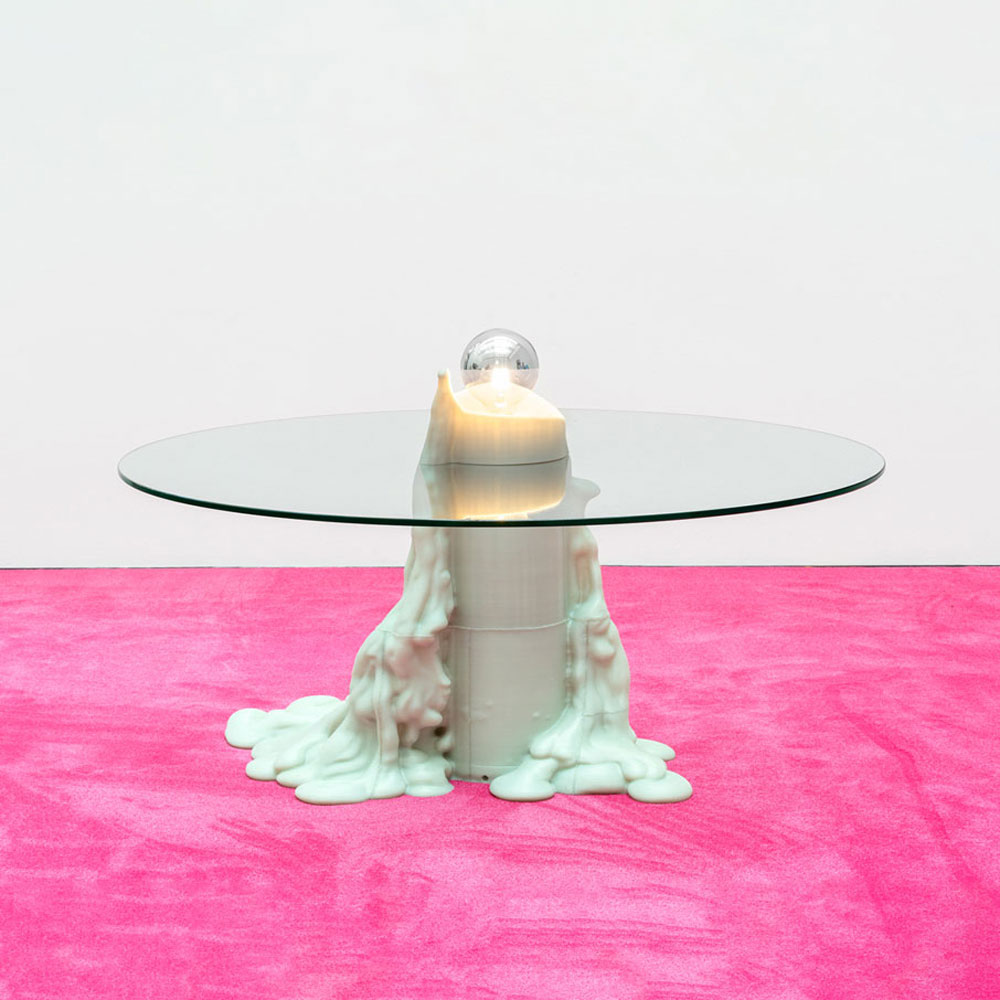PRESENTATION: Allein sein ist wunderschön…
 Borrowing from the eponymous German interior design magazine “SCHÖNER WOHNEN” (live more beautifully), all the works the group exhibition, has one of two things in common: either they can be used and therefore have a practical value, or they at least intimate they have a use, have a shape or title that alludes to consumer goods or refer to architecture: They illuminate, divide, or separate the space, offer all manner of opportunities to sit, recline, or to hang things.
Borrowing from the eponymous German interior design magazine “SCHÖNER WOHNEN” (live more beautifully), all the works the group exhibition, has one of two things in common: either they can be used and therefore have a practical value, or they at least intimate they have a use, have a shape or title that alludes to consumer goods or refer to architecture: They illuminate, divide, or separate the space, offer all manner of opportunities to sit, recline, or to hang things.
By Efi Michalarou
Photo: Galerie Bärbel Grässlin Archive
Tobias Rehberger’s ensemble of luminaires “Allein sein ist wunderschön…” (‘It’s marvelous to be alone’; 2024) hangs in the gallery entrance area, its hand-blow elements reminiscent of falling rain drops. The five painterly elements of Ika Huber’s “Noir d’lvoire” (2012) paravent unite to form a room divider. The gallery’s main hall is sub-divided into various sections that are roughly assigned to the respective artists. 3D-printed works by Tobias Rehberger are arranged on a magenta carpet. The layers of both objects reveal that they are produced by machine. The artist based them on found models such as are constantly available in their thousands as downloads on the Web. By simple manipulation of the templates (distortion, modification in scale, and the addition of lamps) Tobias Rehberger explores the process of finding the right form for an artwork, something he believes is open-ended. Günther Förg’s large-format photograph named “Barcelona Pavilion” (1988-98) depicts an icon of 20th-century architecture created by Mies van der Rohe. The theme of the pavilion becomes increasingly abstract by suggesting a cropped section of the architecture. Meuser’s “Hollywoodschaukel” (‘Hollywood Swing’; 2022) consists of found (industrial) scrap, meaning a material that once had a pragmatic use. That use has now disappeared, not only behind the material’s mechanical treatment, but also behind the surface’s painterly treatment. Meuser chooses titles for his pieces that place them in a new context, ensuring they become objects with a being of their own. Franz West’s furniture sculptures “Chaiselongue” (2015), “Clubfauteuil” (2015) and “Beistelltisch” (‘Side Table’, 2014-24) are based on the characteristic usability of such items. His many-sided oeuvre stakes a claim in the borderline space dividing sculpture and action, between form and non-form, between functionality and autonomy, between material and independence. With his “Mausefalle” (‘Mouse Trap’; 2004) and his “Vogelfalle” (‘Bird Snare’; 2002) Andreas Slominski subverts the function, context, and substance of a toilet-brush holder and an historical doll’s buggy. His works can quite generally be read as an aesthetic exploration of everyday perceptions of a casual kind. With his ” Vitrine” (1988), Georg Herold develops a visual language replete with wit and critical irony. On display is an arrangement of unusual (everyday) materials such as the handbag filled with concrete, the stag’s antlers, and the labeled concrete blocks and timber slats. Essentially not remotely connected to art and devoid of content, along with the artist’s furrowed brow these items combine to form exciting and complex artistic statements. Michael Beutler’s “Wurstsofa II” (‘Sausage Sofa II’; 2017) consists of pressed paper, wrapped in fruit nets to form the individual sausage elements of the sofa. His pieces are always based on a proto-machine which he uses to print, crumple, wrap, fold or weave the materials. Using them he produces installations that render new aspects of the space visible. Martin Kippenberger’s painting “Sanatorium Haus am See” (‘Sanatorium House on the Lake’; 1984) is part of his group of architectural images, in which he interweaves substantive and formal elements. The shape of Heimo Zobernig’s piece, made of particle board that has only partially been covered in white emulsion, untitled (1999), borrows from a bar counter-top but in terms of formal reduction also brings to mind minimalist sculptures, whereby the perfection of such sculptures is undermined here by the materiality and form of production. Like the other works on show, the “counter-top” straddles the functionality of a utility object and the ‘non-purposiveness’ of an artistic object. The exhibition highlights precisely this ambivalence.
Works by: Michael Beutler, Günther Förg, Georg Herold, Ika Huber, Martin Kippenberger, Meuser, Tobias Rehberger, Andreas Slominski, Franz West, and Heimo Zobernig.
Photo: Michael Beutler, Wurstsofa II, 2017, Courtesy Galerie Bärbel Grässlin
Info: Galerie Bärbel Grässlin, Schäfergasse 46 B, Frankfurt, Germany, Duration: 6/7-31/8/2024, Days & Hours: Tue-Fri 10:00-18:00, Sat 10:00-14:00, www.galerie-graesslin.de/









